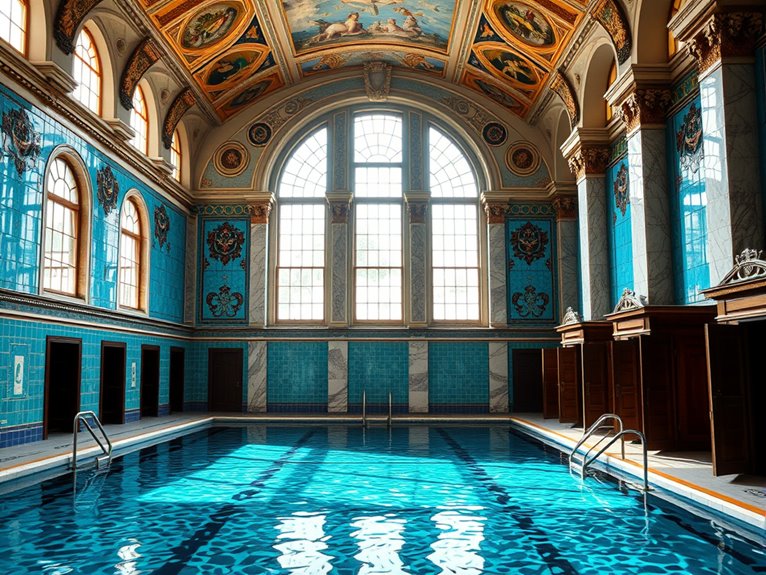
6 Historic Public Baths in Paris With Beautiful Architecture
Paris's historic public baths showcase some of the city's most stunning architecture! I'm excited to tell you about six spectacular venues – from Les Bains De La Butte-Aux-Cailles' 1924 Art Nouveau tilework to Piscine Molitor's grand Art Deco design. You'll find gorgeous mosaics at Piscine Saint-Georges, while Piscine Pontoise dazzles with geometric patterns and stained glass. Don't miss Les Bains Du Temple's Belle Époque beauty or Les Bains-Douches' hidden treasures. These architectural gems hold fascinating stories within their walls.
Les Bains De La Butte-Aux-Cailles: Art Nouveau Splendor in the 13TH
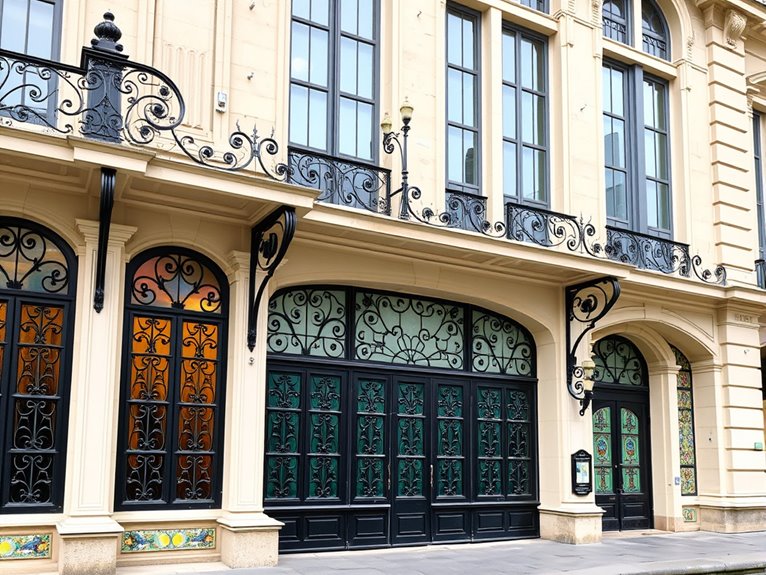
The magnificent Les Bains de la Butte-aux-Cailles stands as a symbol of Paris's rich architectural heritage, embodying the elegance of Art Nouveau design while serving as an essential public amenity since 1924. Located in the charming 13th arrondissement, this historic swimming pool complex represents one of the city's finest examples of municipal architecture from the early 20th century.
Designed by architect Louis Bonnier, the facility combines functional sophistication with artistic beauty, featuring distinctive elements like decorative tile work, elegant iron fixtures, and soaring glass ceilings that flood the space with natural light. Today, it remains both a working swimming pool and a protected historical monument, offering visitors the unique opportunity to swim in an architectural masterpiece while experiencing a beloved local institution.
Quick Facts:
- Opening Hours: Monday-Friday 7:00-20:30, Saturday 7:00-18:00, Sunday 8:00-18:00
- Admission: €3.50 for adults, €1.70 for children
- Best visiting times: Early morning or late afternoon on weekdays
- Photography allowed in common areas only (no pool deck photos)
- Heated pool temperature: 28°C (82.4°F)
- Required items: Swimming cap, proper swimwear
- Facilities: Changing rooms, lockers, showers, small café
Main Pool Hall
The jewel of the complex is the 33-meter main pool, surrounded by original Art Nouveau tiles and topped with a stunning glass roof. The pool maintains its historic character while offering modern amenities, including heated water and contemporary filtration systems. The original brass fixtures and decorative elements have been meticulously preserved, creating an atmosphere that transports swimmers to the elegant 1920s.
Winter Garden
A unique feature rarely mentioned in guidebooks is the winter garden area, accessible to visitors even without swimming. This peaceful space showcases original plant arrangements and period furniture, offering a perfect spot for relaxation or photography.
Pro Tips:
The best time to experience the baths is during "heritage hours" (typically 10:00-12:00 on weekdays) when local swim clubs are absent and tourist crowds haven't yet arrived. For the most atmospheric photos, visit during winter months when steam rises from the heated pool, creating a mystical ambiance under the glass ceiling. Consider combining your visit with exploration of the charming Butte-aux-Cailles neighborhood, known for its village-like atmosphere and excellent local restaurants.
Practical Advice:
Advance booking isn't necessary, but visitors should bring exact change for entry and locker rental (€1 coin required, returnable). The facility provides basic amenities, but bringing your own towel is recommended. Non-swimmers can purchase a visitor's pass to tour the historic building, though access to pool areas may be restricted during busy times. Remember that French swimming pools have strict hygiene rules – shower before entering the pool and wearing a swimming cap is mandatory.
Piscine Saint-Georges: A Neo-Classical Masterpiece
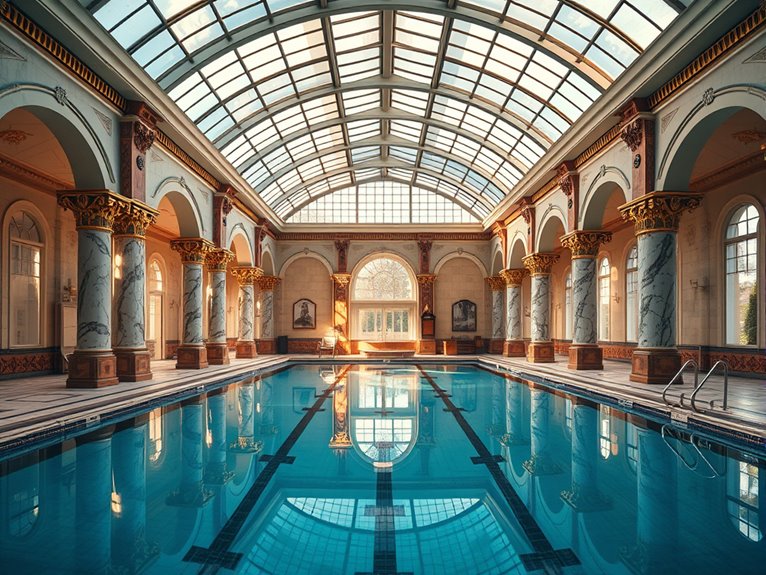
The Piscine Saint-Georges stands as one of Paris's most stunning examples of 1920s Art Deco architecture, combining functionality with extraordinary aesthetic appeal. Located in the 9th arrondissement, this historic swimming pool has been serving Parisians since its inauguration in 1929, designed by the renowned architect Lucien Pollet who masterfully incorporated elaborate mosaics, stained glass, and decorative elements that transform an ordinary swimming facility into a magnificent architectural monument.
Beyond its architectural significance, the pool represents a pivotal moment in Parisian social history, when public bathing facilities became symbols of modernization and public health reform. Today, visitors can swim in the same waters where countless Parisians have exercised and socialized for nearly a century, all while surrounded by preserved period details including original changing cabins, decorative ironwork, and stunning overhead natural lighting through the glass roof.
Quick Facts:
- Opening Hours: 7:00 AM – 8:30 PM (Monday-Friday), 8:00 AM – 6:00 PM (Weekends)
- Admission: €5 for adults, €3 for students/seniors
- Best visiting times: Early morning or late afternoon to avoid crowds
- Photography allowed before/after swimming hours with special permission
- Locker facilities available (bring your own lock)
- Mandatory swimming cap policy
- No food or drinks allowed poolside
The 33-meter pool features pristine water maintained at a comfortable 27°C (80.6°F) year-round. The facility's most distinctive architectural elements include the magnificent glass ceiling, which bathes swimmers in natural light, and the intricate mosaic work depicting aquatic themes in blues and greens. The second-floor gallery offers spectacular views of the pool and serves as a reminder of when swimming was considered a spectator sport in early 20th-century Paris.
Pro Tips:
The ideal time to experience Piscine Saint-Georges is during weekday mornings, particularly Tuesday and Thursday, when local swim clubs aren't practicing. For photographers interested in capturing the pool's architectural details, contact the administration office at least one week in advance to arrange a special photography session during non-operating hours. The morning light through the glass ceiling creates particularly stunning effects between 8:00 AM and 10:00 AM.
Practical Advice:
Visitors should come prepared with their own swimming gear, including mandatory swimming caps (available for purchase at the front desk if needed). While lockers are provided, bring your own lock. The changing rooms maintain their historic character but have been modernized for comfort and security. Non-swimmers can access the second-floor gallery for a reduced fee to appreciate the architecture and atmosphere. It's advisable to check the facility's website for scheduled maintenance closures and special events before visiting.
Les Bains-Douches De La Petite Roquette: Hidden Gem of the 11TH
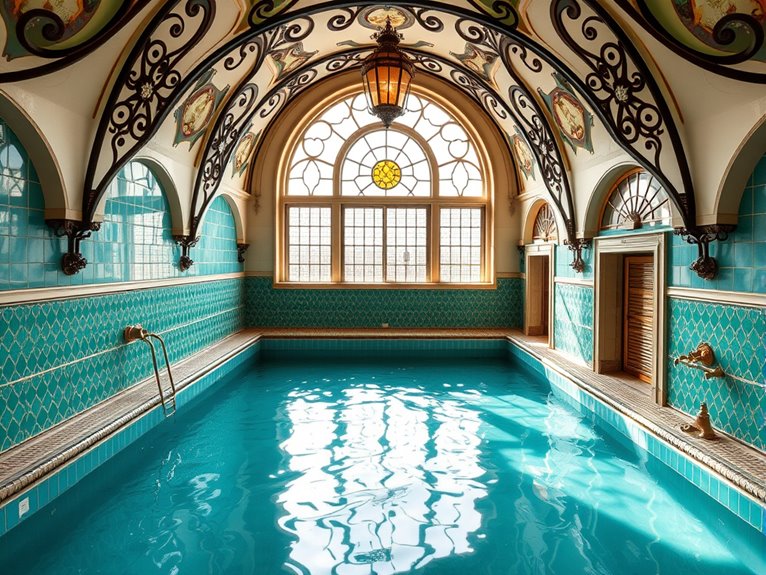
Tucked away in Paris's vibrant 11th arrondissement, Les Bains-Douches de la Petite Roquette stands as a remarkable indication of the city's commitment to public hygiene in the early 20th century. This beautifully preserved public bathhouse, constructed in 1908, offers visitors a unique glimpse into Parisian working-class life during an era when private bathrooms were a luxury few could afford.
The bathhouse's distinctive Art Nouveau architecture and original tile work make it one of the finest surviving examples of municipal bath facilities in Paris. While no longer operational as a public bathing facility, the building has been carefully restored and now serves as a cultural center, hosting exhibitions and community events that celebrate both its historical significance and contemporary artistic expression.
Quick Facts:
- Opening Hours: Tuesday-Saturday, 10:00-18:00
- Admission: Free for general access; special exhibitions may require tickets (€5-12)
- Photography: Permitted without flash
- Guided Tours: Available first Saturday of each month
- Accessibility: Limited wheelchair access
- Language: Information panels in French and English
Historical Architecture
The building's façade features distinctive Belle Époque elements, including intricate ironwork and decorative ceramics that reflect the period's architectural grandeur. The original entrance hall maintains its historic turnstiles and ticket booth, while the main bathing hall showcases stunning vaulted ceilings and period-appropriate lighting fixtures. Location: 2 Rue de la Roquette, 75011 Paris.
Cultural Programming
The transformed space now hosts rotating exhibitions focusing on local history, contemporary art, and social issues. The former waiting room serves as an intimate gallery space, while the main hall accommodates larger installations and performances. Monthly programs often include workshops related to public health history and urban development.
Architectural Details
Original features include hexagonal floor tiles, enameled brick walls, and preserved wooden cubicles that once served as private bathing stalls. The building's innovative ventilation system, revolutionary for its time, remains visible and helps visitors understand early 20th-century engineering solutions.
Pro Tips:
Visit during the annual European Heritage Days (Journées du Patrimoine) in September when special behind-the-scenes tours reveal usually restricted areas, including the original boiler room and maintenance tunnels. Photography enthusiasts should arrive early on overcast days when natural light filtering through the restored skylights creates ideal conditions for capturing the interior's architectural details.
Practical Advice:
Combine your visit with a walk through the historically rich Roquette neighborhood, known for its connection to the former women's prison that gave the bathhouse its name. Consider downloading the facility's mobile app before visiting, which offers an augmented reality experience showing how the baths functioned during their heyday. The nearest Metro stations are Voltaire (Line 9) and Richard Lenoir (Line 5), both within a 5-minute walk.
Piscine Pontoise: Art Deco Grandeur in the Latin Quarter
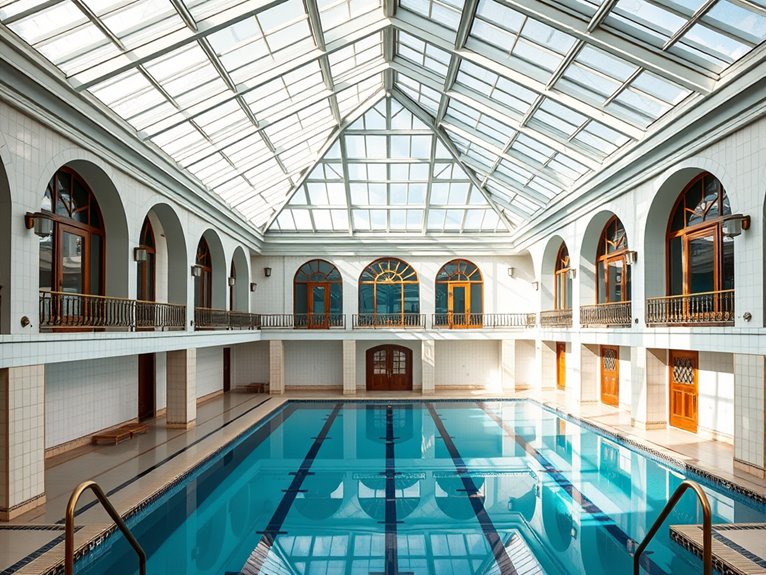
The Piscine Pontoise stands as a stunning showcase to 1930s Art Deco architecture in Paris's vibrant Latin Quarter. This historic swimming pool, opened in 1934, combines athletic functionality with the elegant aesthetic of its era, featuring geometric patterns, original brass fixtures, and striking stained glass windows that cast ethereal light patterns across the water's surface.
Beyond its architectural significance, the Piscine Pontoise offers modern Parisians and visitors a unique opportunity to swim in a living piece of history. The 33-meter pool maintains its original two-level structure with individual changing cabins overlooking the water, creating an atmosphere that transports swimmers to the glamorous interiors of the early 20th century while enjoying contemporary amenities.
Quick Facts:
- Opening Hours: Monday to Friday 7:00-23:30; weekends 7:00-19:00
- Admission: €4-7 (varies by time and age)
- Best Times: Early morning or late evening for fewer crowds
- Photography: Allowed during specific hours with prior permission
- Facilities: Heated pool, sauna, fitness room
- Access: Metro Line 10 (Cardinal Lemoine or Jussieu stations)
- Dress Code: Proper swimming attire required; caps mandatory
Main Features:
The Art Deco Architecture
The building's distinctive architecture showcases classic Art Deco elements, including geometric iron-framed windows, decorative tilework, and elegant brass fixtures. The double-height space creates a cathedral-like atmosphere, with natural light flooding through the massive windows. The original wooden changing cabins on the upper level remain functional and are available for use.
The Swimming Experience
The 33-meter pool maintains a comfortable temperature year-round and offers five lanes for different swimming speeds. The depth ranges from 2 to 3.5 meters, making it suitable for both recreational swimmers and serious athletes. Evening sessions often feature subtle lighting that enhances the historic atmosphere.
Cultural Significance
The pool has served as a filming location for several French movies and continues to host cultural events throughout the year. The facility played a key role in democratizing swimming in Paris during the 1930s and remains an important community center in the Latin Quarter.
Pro Tips:
The most magical time to visit is during "nocturnes" (evening sessions) when the pool is illuminated by both artificial and natural light through the stained glass windows, creating a uniquely atmospheric swimming experience. For photographers, request permission in advance and visit during off-peak hours, typically between 14:00-16:00, when the light conditions are ideal and the pool is less crowded.
Practical Advice:
Book a weekend evening slot at least two days in advance, as these times are popular among locals and tourists alike. Bring your own padlock for the lockers, as rentals can be expensive. The facility offers swimming lessons and aqua fitness classes, but these must be booked separately through the pool's administration office. Remember that speedos are mandatory for men (no swim shorts allowed), and swimming caps are required for all visitors – both can be purchased at the front desk if needed.
Les Bains Du Temple: Belle Époque Beauty in Le Marais
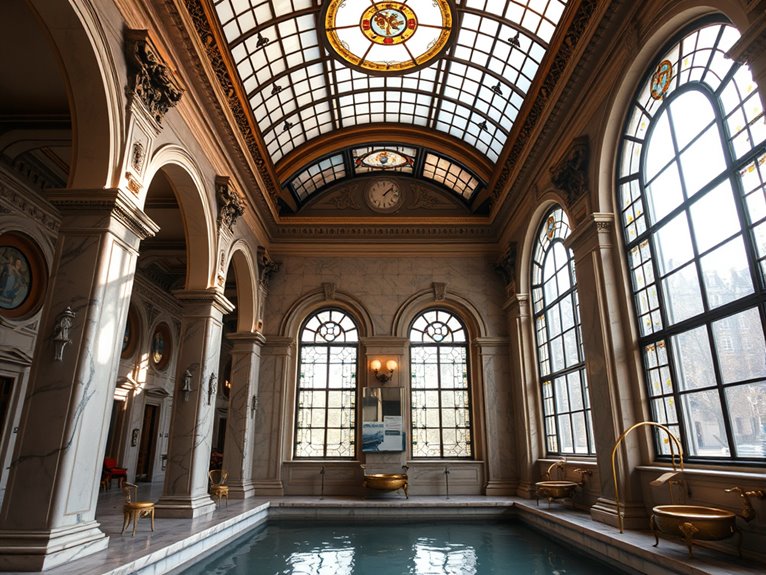
Les Bains du Temple stands as a symbol of Paris's fascinating public bathing history, representing one of the city's most beautifully preserved Belle Époque bathhouses. Located in the historic Le Marais district, this architectural gem has witnessed over a century of Parisian social history since its construction in 1884, offering a glimpse into the public hygiene movement that transformed urban life during the late 19th century.
Today, while no longer functioning as a public bathhouse, the building serves as a cultural landmark and houses various artistic exhibitions and events. Its ornate façade, complete with decorative tiles and classic Belle Époque ironwork, continues to draw architecture enthusiasts and history buffs alike, showcasing the period when public baths were not just utilitarian spaces but symbols of civic pride and social progress.
Quick Facts:
- Opening Hours: Tuesday-Sunday, 10:00-18:00 (closed Mondays)
- Admission: €8 regular, €6 reduced, free for under 18
- Photography: Allowed without flash
- Guided Tours: Available first Sunday of each month
- Accessibility: Limited, historic building with some stairs
- Location: 75 rue du Temple, 3rd arrondissement
- Metro: Temple (Line 3) or Rambuteau (Line 11)
Building Features:
The main hall showcases stunning Art Nouveau tilework and original brass fixtures, with soaring ceilings featuring intricate moldings and period lighting. The central atrium, flooded with natural light through its restored glass roof, offers exceptional photo opportunities. Insider tip: The best light for photography falls between 2-4 PM when sunbeams create dramatic shadows through the glass ceiling.
Historical Elements:
The original changing cabins remain intact, now housing historical exhibits about Parisian bathing culture. The building retains its separate entrances for men and women, marked by distinctive carved signage. Lesser-known fact: Hidden in the basement, visitors can still see the original boiler room with its massive Victorian-era equipment.
Current Usage:
While no longer a functioning bathhouse, the space hosts rotating art exhibitions focused on urban history and social reform. The former pool area serves as an event space for cultural programs. Special access: Ask at reception about the monthly architectural tours that include normally restricted areas.
Pro Tips:
Visit during shoulder season (March-April or September-October) to avoid peak tourist crowds while still enjoying comfortable temperatures for exploring. The building's microclimate can be quite warm during summer months, so morning visits are recommended during July and August. For the best experience, combine your visit with the building's monthly historical lecture series, which offers deep insights into Belle Époque bathing culture.
Practical Advice:
Book guided tours at least two weeks in advance through the official website, as they frequently sell out. Wear comfortable shoes with good grip, as the original tile floors can be slippery. Photography enthusiasts should bring wide-angle lenses to capture the expansive interior architecture. The facility offers limited storage lockers for belongings, so travel light. Nearby cafés in Le Marais provide excellent post-visit refreshment options, with several historic establishments dating to the same period as the baths.
Piscine Molitor: The Grand Dame of Parisian Swimming Pools
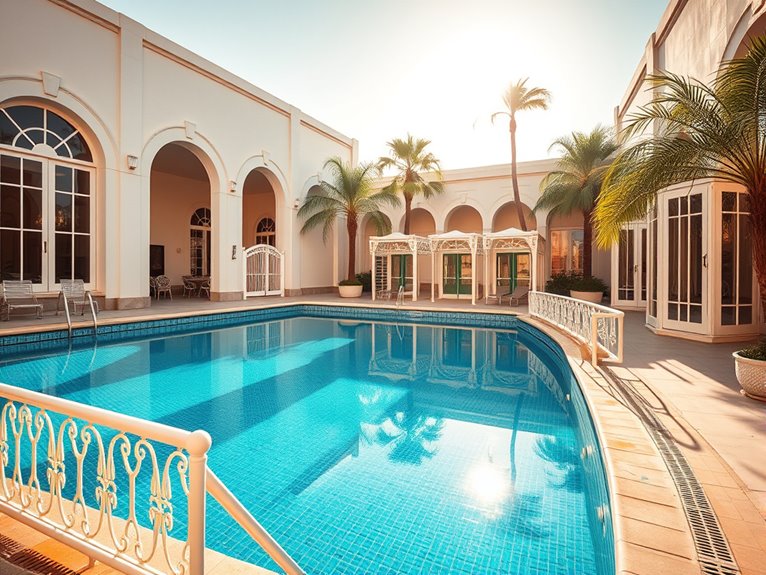
The Piscine Molitor stands as a symbol of Paris's rich architectural heritage and its longstanding love affair with art deco design. Opened in 1929, this iconic swimming facility earned its nickname "the grand dame of Parisian pools" through its elegant design, celebrity clientele, and significant cultural impact – including being the location where the first modern bikini was disclosed in 1946.
After decades of glory followed by abandonment and eventual restoration in 2014, the Molitor has reemerged as a luxury destination that perfectly balances its historic charm with modern amenities. Today, visitors can experience both its famous summer outdoor pool and winter indoor pool, surrounded by the same yellow-hued architecture that made it a landmark nearly a century ago.
Quick Facts:
- Opening Hours: 7:00 AM – 10:00 PM daily
- Price Range: €180-195 for day passes; exclusive to hotel guests and club members
- Best Time to Visit: Early morning for fewer crowds
- Photography Policy: Limited to specific times and areas
- Facilities: Two pools (indoor and outdoor), spa, restaurant, rooftop bar
- Temperature: Indoor pool (28°C/82°F), Outdoor pool (heated year-round)
- Access: Metro Line 10 (Porte d'Auteuil)
The Summer Pool
The outdoor pool remains the Molitor's crown jewel, measuring 46 meters in length and surrounded by three tiers of blue-and-white striped changing cabins. The art deco architecture creates a striking backdrop for swimmers, while the heated water guarantees year-round comfort. The pool area frequently hosts exclusive events and fashion shows, continuing its tradition as a cultural hotspot.
The Winter Pool
The indoor pool, measuring 33 meters, provides a more intimate swimming experience beneath a stunning glass roof. The space features restored 1930s stained glass windows and maintains its original architectural details. Insider tip: The morning light through the glass roof creates exceptional photo opportunities between 8-9 AM.
The Rooftop Bar
A lesser-known feature is the rooftop bar, offering panoramic views of Paris and the Roland Garros tennis complex. The space transforms seasonally, featuring a summer garden and winter arrangements. Insider tip: Access to the rooftop is included with day passes, even if you're not swimming.
Pro Tips:
The best experience at Molitor comes from timing your visit strategically. Book a day pass for a Wednesday or Thursday when occupancy is typically lower. The outdoor pool is less crowded during lunch hours (1-3 PM), while the indoor pool sees fewer visitors in the late afternoon. For photography enthusiasts, the golden hour just before sunset creates magical lighting conditions around the outdoor pool's art deco features.
Practical Advice:
Advance booking is essential as day passes are limited. Bring your own swimming cap (required) or purchase one on-site. The facility provides towels, but bringing flip-flops is recommended. While expensive, combining a pool visit with lunch at the restaurant can make the experience more cost-effective, as dining guests sometimes receive preferred rates for pool access.
